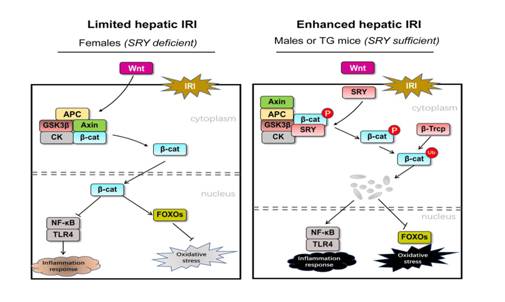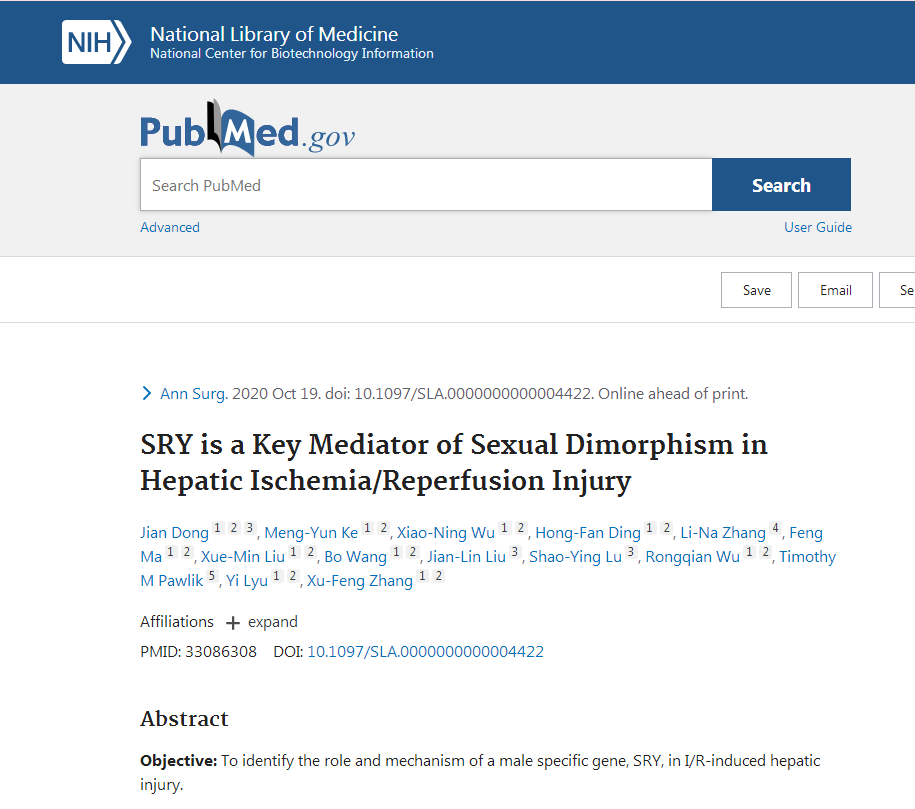Liver resection and liver transplantation are the most efficacious treatments for liver cancer and end-stage liver diseases. However, both hepatectomy and liver transplantation almost block the hepatic port, which leads to liver ischemia-reperfusion (I/R) injury. Intraoperative liver I/R injury not only causes direct damage to a large quantity of hepatocytes, but also affects the regeneration capability of hepatocytes, which is a major reason that affects the success rate of liver surgery and leads to postoperative liver failure and even death. Consequently, identifying the influencing factors of liver I/R injury and exploring the specific mechanism underlying liver I/R injury play a significant role in establishing reasonable postoperative nursing plans, implementing targeted intervention measures and improving postoperative survival rate.

Clinical studies have demonstrated that gender differences exist in liver I/R injury. Female patients are more tolerant of I/R injury than male counterparts, whereas the specific mechanism remains elusive. Sex-determining region on Y chromosome (SRY) is a gene fragment on Y chromosome that determines the male sex of mammals, which induces the gonad to develop into testis during the embryonic stage. Recently, the team led by Professor Lyu Yi and Professor Zhang Xufeng from Department of Hepatobiliary Surgery of the First Affiliated Hospital of Xi 'an Jiaotong University (XJTU) confirmed that SRY, a male-specific gene, can promote liver I/R injury, which is an important reason for the more severe liver I/R injury in men than in women. First of all, the team cooperated with 11 international medical centers using more than 1,700 clinical cases of hepatectomy validated that the transaminase level, postoperative complications and liver failure in male patients after hepatectomy are higher than those in the female counterparts, confirming that SRY expression level is significantly up-regulated during the liver I/R injury. By establishing a transgenic mouse model of liver-specific over-expression of SRY, the team has confirmed that both SRY over-expression in the liver of male mice and acquired expression of SRY in the liver of female mice can aggravate the liver I/R injury. Regarding the underlying mechanism, the expression of sex-specific gene SRY is up-regulated in the male liver under hypoxia, which promotes liver inflammation, oxidative stress and apoptosis and mediates male sex-specific liver I/R injury by inhibiting the Wnt/β-caten in signaling pathway.
This study illustrates that SRY plays a pivotal role in the male liver I/R injury, which is probably a vital factor mediating gender differences in liver I/R injury and providing theoretical basis for gender-specific prevention and targeted treatment of liver I/R injury.

Relevant outcomes of this study entitled "SRY is a key mediator of sexual dimorphism in hepatic ischemias/reperfusion injury" were recently published inAnnals of Surgery(IF=10.13), a top-notched journal in surgery. Dr. Dong Jian, Associate Research Fellow Ke Mengyun and Dr. Wu Xiaoning from our hospital are the co-first authors. Professor Lyu Yi and Professor Zhang Xufeng are the co-corresponding authors. XJTU is the first and only corresponding affiliation. This work is financially supported by National Natural Science Foundation of China.
The team led by Professor Zhang Xufeng has been devoted to the study of the mechanism of gender differences in liver diseases. Previous researches have found that determining the orientation of gonadal development is not the only function of SRY. SRY is expressed in the male/male liver, which is of physiological and pathological significance. The team established genetically-engineered mice and confirmed that SRY is an important oncogene to promote the incidence of male liver cancer, which fundamentally unravels the major causes for the higher incidence of liver cancer in male than female counterparts (Cancer Letters2017). These research outcomes adds evidence to the role and pathological mechanism underlying SRY gene in liver diseases, which is of application significance for clarifying the pathological mechanism of liver diseases and identifying the therapeutic targets.
Article link: https://pubmed.ncbi.nlm.nih.gov/33086308/